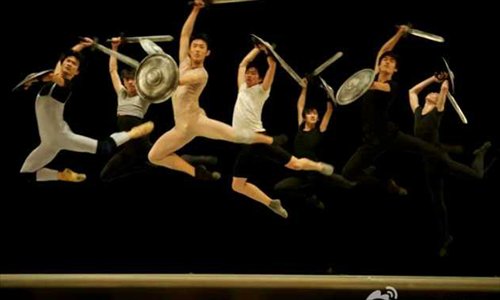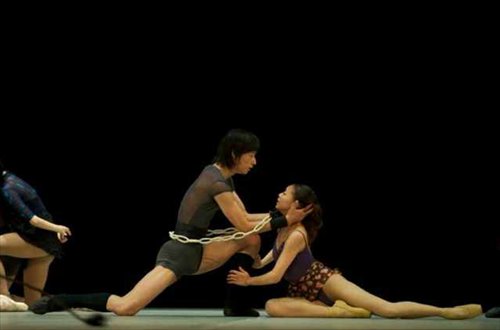No tutu needed

Liaoning Ballet Troupe performs Spartacus.

Spartacus (Jiao Yang) embraces Phrygia (Ao Dingwen). Photos: Courtesy of Liaoning Ballet
Talking about the classics of ballet, almost everyone can name a few of the fairy tales such as Swan Lake, The Sleeping Beauty and The Nutcracker. Others might also know of the romantic Paquita or Giselle.
Liaoning Ballet Troupe is breaking away from the elegant classics by staging a famous but rarely performed 20th century Russian ballet: Spartacus.
The show Spartacus - Hero of the Arena will be performed at the Liaoning Grand Theatre on December 4 and 5 and will come to the National Centre for the Performing Arts December 9 and 10. A world tour is scheduled for 2015.
Working with a Bolshoi veteran
Qu Zijiao, director of the Liaoning Ballet, told the Global Times that she had the idea of putting on Spartacus many years ago but only started the project last year.
The show uses the choreography of Yuri Grigorovich, one of the greatest choreographers in the world.
Grigorovich, 86, was the artistic director and chief choreographer of the Bolshoi Ballet for 30 years and now is the artistic director of his own ballet company.
Grigorovich has choreographed 19 ballets in his lifetime, including the The Nutcracker (1966), Ivan the Terrible (1975), the controversial, happy-ending Swan Lake (1984) and the masculine epic Spartacus (1967).
Qu said that with the help of professor Xiao Suhua at the Beijing Dance Academy, the Liaoning Ballet got in touch with Grigorovich to discuss the project.
"Grigorovich also needed to get to know the Liaoning Ballet," Qu said.
Ultimately, Grigorovich chose to work with the Liaoning Ballet over other troupes in China.
A difficult show
The show is based on the story of the leader of gladiator slaves, Spartacus, who later becomes a hero but tragically dies in the war fighting for freedom.
Composed by Aram Khachaturian in 1954, Spartacus was first performed in 1956.
However, it was Grigorovich's version, which he choreographed in 1967, that made the show a worldwide classic.
According to Qu, Spartacus has been mainly performed by traditional Russian ballet companies such as the Bolshoi Theatre and Mariinsky Theatre. European ballet troupes rarely take it on due to the high technical skill required of the male ballet dancers. The length of the show, with three acts of about 50 minutes each, also creates a physical challenge for the dancers.
Liaoning Ballet, however, is famous for having exceptional male dancers.
As a personal tradition, Grigorovich is bringing his Russian crew to China - conductor, stage designer, costume designer - to ensure that everything remains up to the standard of the classic.
"He is the kind of person that sees his shows as more important than his life and everything else," remarked Qu.
Spartacus, with a cast of 46 male dancers all measuring 1.8 meters or above, is a break from tradition for Liaoning Ballet. It marks the first time the Liaoning Symphony Orchestra will collaborate with a symphony ballet, and it's the show with the most dancers ever in the 33 years of the Liaoning Ballet's history.
"We only perform shows that can fit with our troupe," Qu said, mentioning that the large number of quality male dancers was a result of its affiliated ballet school.
Founded in 1994, the school now has nearly 600 students and staff, including international teachers.
Current principal dancers of Liaoning Ballet like Lü Meng, Jiao Yang, Zhao Yuan and the majority of other talents performing in Spartacus have all had years of classical Russian training at the school.
Taking a risk
Liaoning Ballet Troupe was founded in 1980 and quickly rose to become one of the top three ballet troupes in China. Despite all its other small projects, the troupe produces one big show - either a world classic or an original local work - every year.
Many ballets in its repertoire, such as The Peacock's Gallbladder, Moon, Peony Fairy and The Last Emperor, are Chinese-style shows done to international standards.
For Qu, the direction of Liaoning Ballet is clear: Different shows are created with different markets in mind.
The Last Emperor, for example, was created for the European market and has been well-received internationally ever since its first performance in 2002.
Dance critic and associate professor at the Beijing Dance Academy Mu Yu told the Global Times that Chinese people generally favor Swan Lake.
People working in the industry need to lead the audience to broaden their horizons for different shows with more variety, she said.
"It is hard to predict the audience's response to a show like Spartacus, so the Liaoning Ballet is taking a risk," she said.
"But since the show already has such a high artistic achievement, the cooperation will allow the Chinese professionals to gain experience and also allow the Chinese audience to learn about different styles of ballet."
On the international stage
Mu pointed out that although China now has a lot of great dancers performing at home and abroad as well as the ability to produce high-calibre shows, ballet in China still needs more outstanding choreographers and A-level original productions.
"We have creative local productions but are still in the process of establishing a specific school and style of Chinese ballet," she said.
Mu finds that ballet shows containing the "Chinese manner" have the potential to contribute to high-profile international collaborations, and she provided the example of the 2012 cooperative project The Little Mermaid, which brought together the National Ballet of China and renowned choreographer and director from the US, John Neumeier.
Mu sees that Chinese ballerinas, including those in international ballet troupes like Tan Yuanyuan at the San Francisco Ballet, all possess a certain unique but ultimately Chinese style: quiet and introverted elegance. "No matter whether it's a Chinese story with national ideas and emotions or a Chinese interpretation of a world classic, they are ways Chinese ballet can contribute to the world ballet culture."